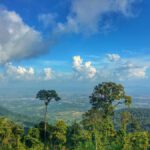Angkor Archaeological Park
Post on : 15 May, 2017 Angkor is one of the most important archaeological sites in South-East Asia. Stretching over some 400 km2, including forested area, Angkor Archaeological Park contains the magnificent remains of the different capitals of the Khmer Empire, from the 9th to the 15th century. They include the famous Temple of Angkor […]
Angkor is one of the most important archaeological sites in South-East Asia. Stretching over some 400 km2, including forested area, Angkor Archaeological Park contains the magnificent remains of the different capitals of the Khmer Empire, from the 9th to the 15th century. They include the famous Temple of Angkor Wat and, at Angkor Thom, the Bayon Temple with its countless sculptural decorations. UNESCO has set up a wide-ranging programme to safeguard this symbolic site and its surroundings.
The temple complex covers some 97 sq. km (60 sq. miles) and carries the remains of passageways, moats, temples, and palaces that represent centuries of building. Originally the stone would have been interspersed with wooden buildings and all the bustle of a living city. A millennium later what there was is gone, eaten by the fierce, humid jungle, and what remains is a magnificent stone skeleton. If you don’t have enough time to explore all temples here, these are some advices about which temple you should visit.
1. Angkor Wat
This is the most well-known temple in Cambodia which was built by King Suryavarman II in the 11th century. Initially, it is a Hindu temple, then it became the Buddhist one after Khmer royal dynasty had embraced Buddhism.
The wat is really large and splendid, surrounded by a big wall. The view there is quite nice and peaceful with a lotus lake in the front that always bring tourists relaxing and comfortable. Due to the fame, Angkor Wat attracts thousands of visitors every year. They flock into the wat before 6 a.m, stand in line along the lake to enjoy sunrise, then visit the wat. Take time for waiting and climbing the tower, you will not be regret on this decision.
2. Bayon
Bayon is located in the center of Angkor Thom, the final capital city Angkor Empire. Originally, it had 54 big and small towers, but now, only 37 are undamaged and still remain.
In each tower there are huge faces carved into stone overlooking four directions. These faces with enigmatic smiles makes Bayon be one of the most impressive temples in Angkor complex.
3. Ta Prohm
Ta Prohm is the most special temple in the Angkor complex, it was built as Bayon style at the end of 12th century to the beginning of 13th century, its initial name was Rajavihara. Ta Prohm was used as a monastery as well as school of Mahayana.
Unlike most Angkorian temples, Ta Prohm is in much the same condition in which it was found: the photogenic and atmospheric combination of trees growing out of the ruins and the jungle surroundings have made it one of Angkor’s most popular temples with visitors. UNESCO inscribed Ta Prohm on the World Heritage List in 1992. Today, it is one of the most visited complexes in Cambodia’s Angkor region.
4. Banteay Srei (Banteay Srey)
Banteay Srei is a 10th-century Cambodian temple dedicated to the Hindu god Shiva. Located in the area of Angkor, it lies near the hill of Phnom Dei, 25 km north-east of the main group of temples that once belonged to the medieval capitals of Yasodharapura and Angkor Thom. Banteay Srei is built largely of red sandstone, a medium that lends itself to the elaborate decorative wall carvings which are still observable today. The buildings themselves are miniature in scale, unusually so when measured by the standards of Angkorian construction. These factors have made the temple extremely popular with tourists, and have led to its being widely praised as a “precious gem”, or the “jewel of Khmer art




